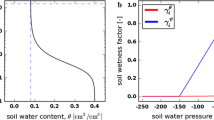Abstract
Modelling the root zone water dynamics in a tree crop agroforestry system is a useful approach to understanding small-scale effects in tree crop systems and may be helpful for optimizing tree spacing in agroforestry system planning. The agroforestry system in this study consists of the species Theobroma grandiflorum (Willd ex Spreng) Schum (Cupuaçu), Bactris gasipaes H.B.K. (peach palm) and the cover crop Pueraria phaseoloides (Roxb.) Benth (Pueraria). The soiltype is an oxisol. Calibration was conducted for each of the three species separately. Calibration results show good conformity between simulated and measured data. Simulated scenarios examine the influence of different spacing between trees on root water uptake, evaporation and drainage. Mean interception and crop factors of the whole flow region vary with spacing or are held constant to examine below-ground effects only. Also a fictitious scenario of an older agroforestry system with deeper roots is calculated. In order to overcome restrictions of the computer program Hydrus-2D, correction factors in the root zone were introduced and a calculation scheme for root water uptake of a flow subregion was developped. Below-ground effects of spacing between trees are not or almost not present, but the depth of the tree roots has a significant influence on root water uptake, evaporation and drainage. When mean interception and crop factor vary, drainage increases and root water uptake decreases slightly with spacing. The modelling approach has been found promising for optimizing agroforestry systems although it can only be seen as a first beginning. In an agroforestry systems under drier conditions differences in results will probably be larger.
Similar content being viewed by others
References
Allen R., Pereira L., Raes D. and Smith M. 1998. FAO Irrigation and Drainage Paper No. 56-Crop Evapotranspiration (Guidelines for Computing Crop Water Requirements). FAO-Food and Agriculture Organization. reprint (2000).
Correia F. and Lieberei R. 1998. Agroclimatological Information About the Experimental Fields of the SHIFT-Area, ENV 23, 42, 45, 54.. In: Lieberei R., Voβ K. and Bianchi H. (eds), Proceedings of the Third SHIFT-Workshop, Manaus, March 15-19, 1998, pp. 389-396. Federal Ministery of Education and Research.
Critchfield H.: 1983. General Climatology, 4th edition. Prentice-Hall, Inc., Englewood Cliffs, New Jersey, USA.
Diegues A.: 1992. The Social Dynamics of Deforestation in the Brazilian Amazon. Discussion Paper No. 36, UNRISD, http://www.unrisd.org/engindex/publ/cat/publont.htm.
Fearnside P. 1985. Environmental Change and Deforestation in the Brazilian Amazon.. In: Diegues A.C. (ed.), cited.
Fearnside P. 1988. An Ecological Analysis of Predominant Land Uses in the Brazilian Amazon.. In: Diegues A.C. (ed.), cited.
Fittkau E. 1990. Zur Ökologie tropischer Regenwälder. In: Amazonien-Ein Lebensraum wird zerstört. München: Raben Verlag, pp. 11–23.
Haag D. 1997. Root Distribution Patterns in a Polycultural System with Local Tree Crops on an Acid Upland Soil in Central Amazonia. Master's thesis, Universität Bayreuth-Lehrstuhl für Bodenkunde und Bodengeographie.
Hess T. and Angood C. 2002. WaSim Water Balance Model. http://www.silsoe. cranfield.ac.uk/iwe/wasim/. Institute of Water and Environment (Cranfield University).
Klinge H., Furch K., Irmler U. and Junk W. 1981. Fundamental Ecological Parameters in Amazonia in Relation to the Potential Development of the Region.. In: Lal R. and Russell E. (eds), Tropical Agricultural Hydrology. John Wiley and Sons Ltd., pp. 19-36.
Larcher,W. 1994. Ökophysiologie der Pflanzen, 5th edition. Ulmer, Stuttgart, Germany.
Martens S., Ustin S. and Rousseau R. 1993. Estimation of Tree Canopy Leaf Area Index by Gap Fraction Analysis. Forest Ecology and Management, 91-108.
Matthews R. 2001a. CUPPA-Tea: A Simulation Model for Tea (Camellia sinensis). Institute of Ecology and Resource Management (University of Edinburgh).
Matthews R. 2001b. HYCAS: A Simulation Model of Resource Competition in Cassava-Based Agroforestry Systems. http://www.silsoe.cranfield.ac.uk/iwe/ research/hycas.htm. Institute of Water and Environment (Cranfield University).
Matthews R. and Hunt L. 2002. HyPAR Agroforestry Model. http://www.nbu.ac.uk/ hypar/.
Muetzelfeldt R. 2001. Simile Homepage. http://www.ierm.ed.ac.uk/simile/index.html. Institute of Ecology and Resource Management (University of Edinburgh).
Nepstad D. 1999. Large-Scale Impoverishment of Amazonien Forests by Logging and Fire. Nature, 505-508.
Noordwijk M.V. and Lusiana B. 2000. WaNuLCAS Version 2.0, Background on a Model of Water Nutrient and Light Capture in Agroforestry Systems. International Centre for Research in Agroforestry (ICRAF), Bogor, Indonesia.
old/prodes95.htm.
Schaap M. 2001. Rosetta. http://www.ussl.ars.usda.gov/models/rosetta/rosetta.HTM. U.S. Salinity Laboratory, Riverside, California, USA.
Schroth G., Silva L.F.D., Wolf M.-A., Teixeira W. and Zech W. 1999. Distribution of Throughfall and Stemflow in Multi-Strata Agroforestry, Perennial Monoculture, Fallow and Primary Forest in Central Amazonia, Brazil. Hydrological Processes, 1423-1436.
Schroth G., Teixeira W., Seixas R., Silva L.D., Schaller M., Macêdo J. and Zech W. 2000. Effect of Five Tree Crops and a Cover Crop in Multi-Strata Agroforestry at Two Fertilization Levels on Soil Fertility and Soil Solution Chemistry in Central Amazon. Plant and Soil, 143-156.
Simunek J., Sejna M. and Genuchten M.T.V. 1999. The Hydrus-2D Software Package for Simulating the Two-Dimensional Movement of Water, Heat and Multiple Solutes in Variably-Saturated Media. U.S. Salinity Laboratory-Agricultural Research Service-U.S. Department of Agriculture, Riverside, California, USA. Version 2.0.
Teixeira W. 2001. Land Use Effects on Soil Physical and Hydraulic Properties of a Clayey Ferralsol in the Central Amazon. Ph.D. thesis, Universität Bayreuth, Bayreuth, Germany.
Vincent G. 2001. A Spatially Explicit Individual-based Forest Simulator. http://www.icraf.cgiar.org/sea/AgroModels/SExI/SExl.htm. International Center for Research in Agroforestry.
Voβ K., Feldmann F., Gasparotto L. and Lieberei R. 1998. Root Development of Tropical Useful Plants in the Early State of Plantation on Degraded Sites in Amazonia.. In: Lieberei R., Voβ K. and Bianchi H. (eds), Proceedings of the Third SHIFT-Workshop, Manaus, March 15-19, 1998, pp. 351–358. Federal Ministery of Education and Research.
Author information
Authors and Affiliations
Corresponding author
Rights and permissions
About this article
Cite this article
Schlegel, P., Huwe, B. & Teixeira, W. Modelling species and spacing effects on root zone water dynamics using Hydrus-2D in an Amazonian agroforestry system. Agroforestry Systems 60, 277–289 (2004). https://doi.org/10.1023/B:AGFO.0000024422.96670.63
Issue Date:
DOI: https://doi.org/10.1023/B:AGFO.0000024422.96670.63




